Aankit Patel
Chess Revealed
The unseen elements of chess are revealed to help educate and delight those new to the game.
http://www.aantiks.com/tag/chess/

Classes
Introduction to Computational Media,Introduction to Physical Computing
Introduction to Computational Media,Introduction to Physical Computing
Chess Revealed has two aspects - one a physical, interactive chess board and the other an on-screen revisualization.
The interactive chess board, which won a small grant from the new NYU Prototyping Fund, uses light and sound to engage and educate people that may otherwise never get past learning the names of the pieces. Encased in colorful acrylic, the board is designed to teach players how to set up the game and how each piece can be moved. I am exploring the ideas and challenges around student guided/motivated learning that are quickly becoming part of mainstream education vernacular.
Similarly the on-screen revisualization explores whether beginners can immediately start playing chess without any instruction. The difference is that by using a screen, a great deal more information can be communicated at once. Built in Processing, this revisualization is a playable chess game with a board that changes with each move, showing the shifting balance of power. I'd like to learn whether the user is confused and stressed or empowered and delighted by a wealth of information.
The two projects are inspired partly by the work of Sugata Mitra and Emily Pilloton and are my first attempts at building technology that assists and hopefully motivates learning.
Background
I was primarily inspired by Sugata Mitra, an professor of education technology, and his 'Hole in the Wall' experiments which gave children in poor Indian villages to free, unfettered access to computers. Mitra found that children were able to learn about and even solve highly complex science and math problems posed in English even though they had never learned the science/math and had very little English.
In terms of technical research, I studied the very large and active online chess community. There are a lot of others who have built chess computers with the focus of playing games against artificial intelligence at a physical board instead of a screen. A former ITPer blogged about using resistors in pieces so the Arduino could individually identify them - an idea that I am using.
Audience
Children excited to learn chess and adults who are afraid or bored by the game.
User Scenario
The user and a friend will plug in the board. The lit up squares will prompt the user to try plugging in the pieces. Through some experimentation and simple light and sound feedback from the board, the user will figure out the correct starting for the pieces and then the game will start. The board will indicate whose turn it is through the same feedback system and the game will begin. When the user picks up a piece to move, the board will show the user what squares are valid moves.
The users are delighted to be able to immediately play without having to read and remember a bunch of rules, but are equally excited to be learning how to play chess.
The interactive chess board, which won a small grant from the new NYU Prototyping Fund, uses light and sound to engage and educate people that may otherwise never get past learning the names of the pieces. Encased in colorful acrylic, the board is designed to teach players how to set up the game and how each piece can be moved. I am exploring the ideas and challenges around student guided/motivated learning that are quickly becoming part of mainstream education vernacular.
Similarly the on-screen revisualization explores whether beginners can immediately start playing chess without any instruction. The difference is that by using a screen, a great deal more information can be communicated at once. Built in Processing, this revisualization is a playable chess game with a board that changes with each move, showing the shifting balance of power. I'd like to learn whether the user is confused and stressed or empowered and delighted by a wealth of information.
The two projects are inspired partly by the work of Sugata Mitra and Emily Pilloton and are my first attempts at building technology that assists and hopefully motivates learning.
Background
I was primarily inspired by Sugata Mitra, an professor of education technology, and his 'Hole in the Wall' experiments which gave children in poor Indian villages to free, unfettered access to computers. Mitra found that children were able to learn about and even solve highly complex science and math problems posed in English even though they had never learned the science/math and had very little English.
In terms of technical research, I studied the very large and active online chess community. There are a lot of others who have built chess computers with the focus of playing games against artificial intelligence at a physical board instead of a screen. A former ITPer blogged about using resistors in pieces so the Arduino could individually identify them - an idea that I am using.
Audience
Children excited to learn chess and adults who are afraid or bored by the game.
User Scenario
The user and a friend will plug in the board. The lit up squares will prompt the user to try plugging in the pieces. Through some experimentation and simple light and sound feedback from the board, the user will figure out the correct starting for the pieces and then the game will start. The board will indicate whose turn it is through the same feedback system and the game will begin. When the user picks up a piece to move, the board will show the user what squares are valid moves.
The users are delighted to be able to immediately play without having to read and remember a bunch of rules, but are equally excited to be learning how to play chess.

